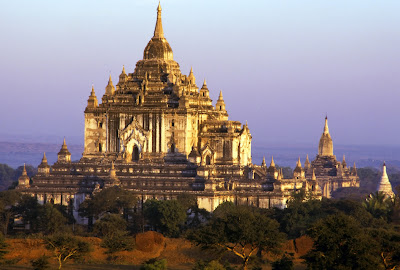Myanmar culture has been closely intertwined with religion and royalty in Burma history. Temples, pagodas and palaces displayed the artistic skills of painters, wood carvers and sculptures. Myanmar Temples and pagodas were traditionally built of brick and many are still standing. The great palaces of Myanmar culture in Myanmar, however, were made of wood, and only one badly-deteriorating example of these beautiful carved structures remains today. Myanmar Art and architecture, which relied on royal support, faded when the last royal kingdom collapsed.
Although court Myanmar culture has been extinguished, popular street-level Myanmar culture is vibrant and thriving. Myanmar Drama is the mainstay of this culture, and just about any celebration is a good excuse for a Myanmar culture pwe (show). Myanmar performances may recount Buddhist legends, or be more light-hearted entertainments involving slapstick comedy, dance, ensemble singing or giant puppets. Burma cultural music is an integral part of a pwe; it originates from Siam and emphasizes rhythm and melody. Myanmar culture instruments are predominantly percussive and include drums, boat-shaped harps, gongs and bamboo flutes.
Over 85% of the Burma population is Theravada Buddhist, although it is not the official state religion and since the Myanmar Ne Win government takeover, it has actually officially occupied a less central role in Burma life. In the Rakhine region, towards Bangladesh, there are many Muslims. Christian missionaries have had some success among hill tribes but many remain staunch animists in Rakhine region.
Burmese is the predominant language and has its own alphabet and script. Though you’re hardly going to have time to master the alphabet, it may be worth learning the numerals, if only so you can read the bus numbers. English is spoken by a few Burmans, particularly by the older generation.
It’s easier to buy authentic Burman dishes from food stalls rather than restaurants. Chinese and Indian eateries predominate, and hotel restaurants tend to remove much of the chilli and shrimp paste from their Burman dishes. Rice is the core of any Burman meal. To this is added a number of curry options and a spicy raw vegetable salad, and almost everything is flavoured with ngapi a dried and fermented shrimp paste. Chinese tea is generally preferable to the over-strong, over-sweet and over-milky Burman tea. Sugar-cane juice is a very popular streetside drink, and stronger tipples include orange brandy, lychee wine and the alarming-sounding white liquor and jungle liquor.
Although a diverse range of indigenous cultures exist in Myanmar, the majority culture is primarily Buddhist and Bamar. Bamar culture has been influenced by the cultures of neighbouring countries. This is manifested in its language, cuisine, music, dance and theatre. The arts, particularly literature, have historically been influenced by the Burmese form of Theravada Buddhism. Considered the national epic of Myanmar, the Yama Zatdaw, an adaptation of Ramayana, has been influenced greatly by Thai, Mon, and Indian versions of the play. Buddhism is practised along with nat worship which involves elaborate rituals to propitiate one from a pantheon of 37 nats.
In a traditional Burmese village, the monastery is the centre of cultural life. Monks are venerated and supported by the lay people. A novitiation ceremony called shinbyu is the most important coming of age events for a boy when he enters the monastery for a short period of time.Every boys of Buddhist family need to be a novice (beginner for Buddhism) before the age of twenty and to be a monk after the age of twenty. It is compulsory for every boys of Buddhism. The duration can be at least one week. Girls have ear-piercing ceremonies at the same time. Burmese culture is most evident in villages where local festivals are held throughout the year, the most important being the pagoda festival.Many villages have a guardian nat, and superstition and taboos are commonplace in Burmese life.
British colonial rule also introduced Western elements of culture to Myanmar. Myanmar’s educational system is modelled after that of the United Kingdom. Colonial architectural influences are most evident in major cities such as Yangon. Many ethnic minorities, particularly the Karen in the southeast, and the Kachin and Chin who populate the north and northwest, practice Christianity.

No comments:
Post a Comment